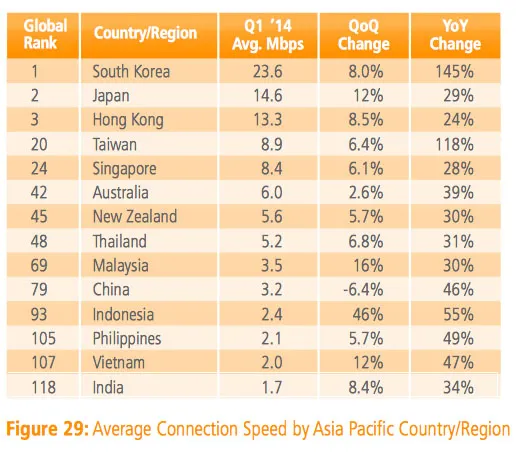India’s Internet speed is the one of the slowest in Asia-Pacific region
It's an irony that on one hand, we have the ecommerce and other internet businesses defining the next revolution in India while on the other hand India has one of the slowest internet connections in the Asia Pacific region.
The recent Akamai’s quarterly report on ‘State of the Internet’ highlights the slow Internet connection in the country. India ranks lowest in the Asia-Pacific region with an average connection speed of 1.7 megabits per second in the previous quarter.

India’s Internet connection speeds of 1.7 megabit per second are no match to the global average of 3.9 megabits per speed. Though there is no regulation of wireless Internet connection speeds in the country, TRAI has decided to set a minimum rate for wireless Internet services.

India’s speeds have increased over 8% from last year while most Asian countries have witnessed an increase of over 20% YoY. South Korea recorded the highest average connection speed at 23.6Mbps, and the highest average peak connection speed at 68.5 Mbps.
The report also reveals that India had the lowest rate of high broadband adoption among qualifying countries, at 0.4%, even after a 31% quarterly increase.
South Korea and Hong Kong are the only two surveyed Asia Pacific countries/regions with average peak connection speeds above 60 Mbps, while Singapore, Japan, and Taiwan remain the only others with average peak speeds above 50 Mbps.
In terms of average peak connection speeds, Indonesia has witnessed one of the most aggressive growths that added 55% from the fourth quarter of 2013, while Taiwan added only 2.1%. New Zealand was the only other country to see a double-digit percentage increase. Declines ranged from a 1.2% loss in China to a 10%, while the lowest was seen in India, at 0.7%.
But there is some hope as Cisco Visual Networking Index Global Forecast and Service Adoption for 2013-2018 predicts Internet speeds - broadband as well as mobile – to triple in India in four years.
This Cisco report claims that the average broadband speeds will rise from 3Mbps in 2013 to 9Mbps in 2018. Cisco's report dues that the average Internet user in India will generate around 4.7GB of traffic per month in 2018, an increase of 117 percent from 2013. The findings say an eight-fold increase in video traffic by 2018 could be one of the reasons behind the rising IP traffic. The report also claims that IP video traffic would account for three-quarters of all IP traffic by 2018.
The Akamai report also touched on the rising concerns over Internet security. As the most targeted port in the first quarter, Port 445 was the top target port in just four of the top 10 countries: Taiwan, Russia, India, and Romania, while it was the second most targeted port in the United States, Brazil, and South Korea. Port 5000 was the top target port in China, Brazil, Turkey, and South Korea, and the second most targeted port in India and Romania. Port 23 placed within the top three in China, Brazil, India, Turkey, South Korea, and Romania, likely associated with attacks looking for open Telnet ports, where brute force or default logins can be attempted in an effort to gain access to, and control of, a target system.
The new government under the leadership of Narendra Modi has assured of stern expansions in telecom and Internet access in the country making broadband high speed.
The assurances included increase of the Internet connectivity along with increase in speeds too. While major metropolitans will see fiber networks within the next 6 months, low connectivity states will get access to ADSL.
In the past few weeks, Airtel, Reliance Jio Infocomm, Vodafone and Idea Cellular have announced their plans to start 4G services in the country. Airtel has already rolled out the service in 6-7 cities.
India needs better Internet speeds to cater to the growing demands of consumers and also to fuel the next wave of consumer Internet products.







